Originally posted at: http://www.nerdfitness.com/
 If you want to learn the overhead press, you’ve come to the right place!
If you want to learn the overhead press, you’ve come to the right place!
We help many of our coaching clients pick up barbells for the first time, including how to perform the overhead press safely and effectively.
Today we’ll share the same lessons we teach our clients so you can get started with the overhead press.
Here’s what we’ll cover:
- Why you should start pressing (What muscles does the overhead press work?)
- What is the overhead press?
- How to set up the press
- How to perform the overhead press (with video tutorial)
- 4 common mistakes to avoid with the overhead press.
- Variations of the press
- FAQ on the overhead press (including starting weight)
- How to get better at the overhead press
A quick note: we have compiled this article and ALL of our strength training content into a comprehensive guide that will remove all the confusion and answer all the questions you have about weight training! Grab our guide, Strength Training 101: Everything You Need to Know, when you sign up in the box below!
- Everything you need to know about getting strong.
- Workout routines for bodyweight AND weight training.
- How to find the right gym and train properly in one.
Why You Should Start Pressing

“The day the barbell was invented, the guy who invented it figured out a way to pick it up and shove it over his head. After all, it is the logical thing to do with a barbell.” – Mark Rippetoe, Starting Strength
Years ago, there were actually three weightlifting lifts in the Olympics – the press, the snatch, and the clean and jerk.
While it’s a poor quality video, the lift is crazy impressive.
Unfortunately, after much controversy, the press was removed from competition by the Olympic Committee in 1972.
When the press was eliminated, people started moving in two distinct directions:
- Bodybuilding
- Powerlifting
Powerlifting uses the bench press instead of the overhead press as the test of upper body strength, while bodybuilding is focused on aesthetics. This meant many people stopped overhead pressing all together! Throw in the emergence of weight machines in the 70’s, and the press’s dwindling in mainstream popularity isn’t a surprise.
Once upon a time, people would ask “how much do you press?” rather than “how much do you bench?”

Although this mindset has been lost among the lifters of today, let’s take a look at why YOU need to be pressing:
- The press is an overlooked compound movement that builds strong shoulders, chest, and arms, while also working the rest of your body. The press helps improve deficiencies in your overall upper body strength, translating to improved numbers on the bench press, chin-ups, rows, and more. If you are plateauing on any of these, try focusing on the press for a few weeks and see how much it helps!
- The press acts as an assistance exercise for just about any sport in which you have to transmit force from the ground through your hands. This can include anything from throwing a baseball to pushing against an opponent in a sport like rugby or football.
- Since you are standing (and not sitting or leaning against any object like in a bench press), the press helps to develop your core and stabilizer muscles in your trunk, as well as point out imbalances in your back. When your upper back is being supported by a bench, there is a lot of room for imbalances to be masked. In the press, there is nowhere for those imbalances to hide. Mwahaha!
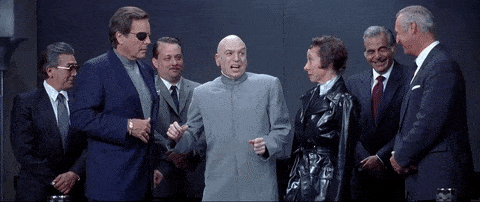
- Lastly, including the press in your routine helps you develop as a well-rounded nerd/athlete and helps strengthen your shoulders, rotator cuff, scapula, and upper back (amongst everything else) and will help protect you against injury.
Plus, imagine where Link would be if he couldn’t do the overhead press?

Showing off new found treasure is half the fun!
Cue the “Duh, nuh, duh NAHHHHH!!!”
What Is the Overhead Press?

First of all, let’s talk about exactly what an overhead press is.
An overhead press (more correctly called the ‘press’) is when you stand with the bar at your shoulders, and press upwards ending up with the bar overhead.

There are many different variations of the press, including:
#1) The Seated Press (where you are… wait for it… seated)

#2) The Bench Press (where you lay with your back on a bench – we cover the bench press in this guide)

#3) The Dumbbell Press (where you use dumbbells)
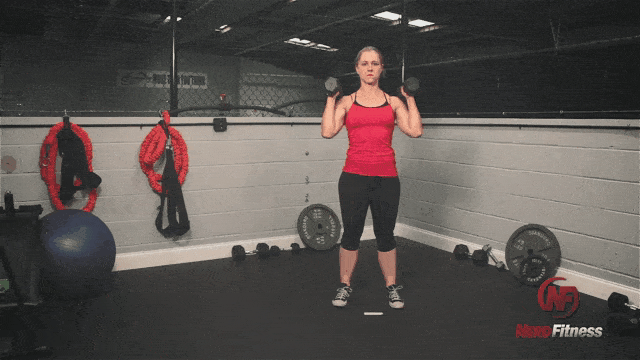
#4) The Military Press (where you stand with your heels together)

#5) The Arnold Press (starting with the forearms supinated and ending with the forearms pronated)

#6) The Push Press (where you use some leg drive to help you get the bar overhead)

#7) The Power or Push Jerk (where you drop under the bar instead of pressing it up)

#8) The Split Jerk (where you drop under the bar and land in a lunging position, and then stand up with the bar)

But the overhead press, ”THE PRESS,” is the original.
We will discuss some of these variations later in this article, but we’ll primarily be focusing on the classic two-handed barbell overhead movement.
Here’s how to get started with the overhead press:
Preferably you’ll have:
- A Squat Rack
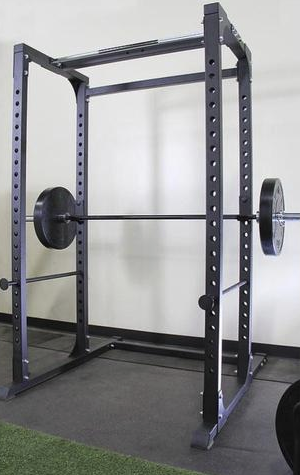
- A Bar

(Don’t be afraid to start with a lighter bar. For a lot of beginners, the 45lb bar is too heavy – it was for my first few months of lifting!)
The rack should be set at the same height as if you were going to squat – so that the bar is at the same height as your collarbone.
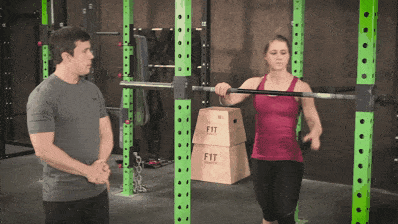
When in doubt, go lower versus higher – you don’t want to have to get on your toes to get the bar into the right position.
Now, when setting up the overhead press the goal will be to create the most efficient path for the bar. This will allow us to apply the most force as possible, and lift the most amount of weight.
We’ll be going in-depth on this movement below, so don’t get overwhelmed!
Plus, if at any time you do get frustrated, we are here to help!
Our Coaching Program will partner you with a trained professional who will teach you how to lift barbells, design a custom workout routine, and check your form through our snazzy app!
How to Set up the Overhead Press
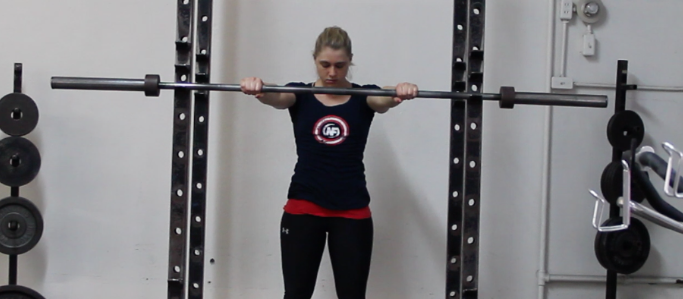
In order to create a position that gives you the most leverage, we are pressing from our shoulders STRAIGHT overhead – the most efficient path is straight up in a vertical line.
Walk up to the bar so that you are right up against it, placing your hands just outside your shoulders.

Your elbows and forearms should be in a vertical position, straight up and down. If your elbows are pointing outward or inward (instead of straight down), your grip is either too narrow or too wide. Experiment with this and adjust accordingly.

As you grip the bar, keep this position (vertical).
Be sure you place the bar on the heel of your palm – not on the middle or top part, or on your fingers (pictured below).
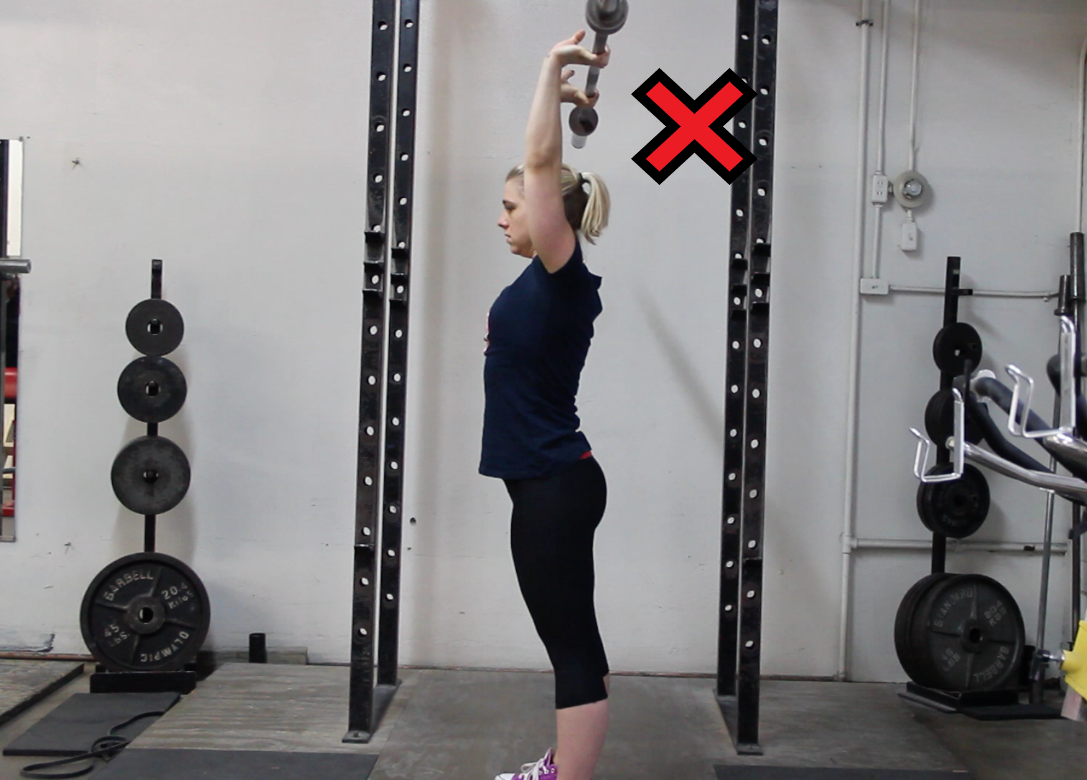
The heel of the palm is where we will be able to generate the most force – think about how much force you can generate with your fingers or even the top half of your hand versus the bottom of your palm.

The bottom of your palm allows you to apply force that is supported by your entire forearm, so we want the bar to be placed there.
When you look from the side, your elbows should be slightly in front of the bar, not behind or in front, like in a front rack position for the front squat.

One good way to think of it is that you want your middle knuckles to be facing upward, towards the ceiling.
QUICK FORM CHECK: Now that you have your hands the proper width apart, and the bar is resting on the correct part of your hand, wrap your thumb around the bar (keeping your middle knuckles facing towards the sky) and take the bar out of the rack.

To ensure you have the setup correct, record a video of yourself and match it here against our videos and gifs.
If you want to have a trained professional review your form, our coaches can do just that in our spiffy app!
How to Perform the Overhead Press (With Video Tutorial)

We are now ready to do some lifting!
At this point, from the back, your elbows and forearms should form a perpendicular line with the bar, and from the side, your elbows should be slightly forward of the bar, and your forearms are vertical.

The bar should be resting on your anterior deltoids:

However, if you have extra long forearms, the bar may not rest on your shoulders, you may be holding it somewhere between your shoulders and your chin.
Stand with your legs about shoulder-width apart – the same as your squat stance.

Look straight in front of you (not down or up). You should keep this head position throughout the entire lift – it’s good to pick a spot in front of you and stare at that one spot the entire time.

Next, you are going to want to stand with your chest up and out – think of pulling your shoulder blades back and together slightly and standing with your shoulders back and your chest up, as if you were in the military, or Donkey Kong ready to pound his chest.

Now, we need to press the bar over our heads, in as straight a line as possible. We want to end in a position where the bar is over the mid-foot, forming a straight line. You don’t want the bar to be behind you, or out in front of your head.
What’s that, you say? Your head is in the way?

Yup.
This means we’ll need to move our head so that the bar can move in a straight line. To do this, lean back and push your hips forward (squeeze your glutes and keep them squeezed throughout the entire lift.)
Don’t lean back by arching your back, but simply by squeezing your glutes and pushing your hips forward. With this movement, you’ll lean your head slightly back and out of the way.

You’re now ready for the press!
Here’s a video from the Nerd Fitness Academy, walking you step-by-step on how to perform the overhead press:
To perform the overhead press:
- Unrack the bar.
- Stand with your feet about shoulder-width apart.
- Lean back by pushing your hips forward.
- While keeping your entire body tight, press the bar overhead.
- Keep the bar as close to your face (without hitting it) as possible.
- Once the bar passes your forehead, move your body back under the bar by driving your torso forward and back into a standing position.
- At the top of the lift shrug your shoulders slightly and lock your elbows.
The entire time, from when you take the bar out of the rack, until you put the bar down, keep your body tight. It may be less weight than you are squatting, deadlifting, or benching, but if you don’t keep your body tight you will miss the lift!
A few things to think about in order to keep everything super tight during the overhead press:
- When you grip the bar, squeeze the bar as if you are trying to make it bend upwards. When you do this, you will engage your lats.
- At the same time as you are squeezing the bar, squeeze your elbows in as if you are trying to keep the insides of your biceps touching your chest at all times.
- Right before you lift, take a deep breath in, and hold the air in your stomach. Brace your abs, squeeze your glutes, and then start pressing up. Let the air out at the top of the lift.
And that’s it!

Want to know HOW to mix overhead presses into your workouts? Not sure what you should be doing every day you walk into the gym?
That’s okay! You seem like a nice person and a perfect fit for our coaching program
4 Common Mistakes to Avoid with the Overhead Press

As you can see, the basic premise of the press is pretty simple – push the bar overhead in a straight line. However, it’s actually an extremely difficult lift and a hard lift to master. Here are a few of the most common faults that we see:
1) Bar path isn’t straight:
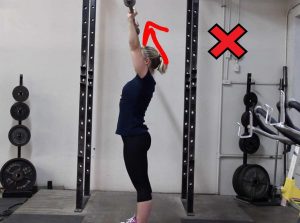 You want the bar to go as straight upwards in as vertical a line as possible. You don’t want it to go out forward. There are a few things that typically cause this:
You want the bar to go as straight upwards in as vertical a line as possible. You don’t want it to go out forward. There are a few things that typically cause this:
- You don’t lean back to move your head out of the way
- Your starting position is incorrect, with your forearms not vertical to the floor with your elbows in front of the bar. If your elbows start behind the bar, with your forearms at an angle, the bar will move forward.
- You don’t get under the bar after leaning back.
2) Lean too far back and create a standing incline bench press:

The lean back can be very slight, and initiated with the hips.
Don’t lean back by arching your back. Make sure to remember to squeeze your glutes and stay upright!
3) Not keeping your body tight, letting your core go weak or letting your chest round.
You need to keep your chest up the entire time, with your shoulder blades slightly contracted, as well as your core tight. When you let your core go loose, problems start to appear.
4) Looking up, instead of straight: 
You should be looking straight ahead – not up or down, throughout the entire lift.
Variations of the Overhead Press

Depending on your goals and equipment, you may opt to do a press variation of the press instead, or use one of these as an accessory to help increase your press.
If you are unsure or haven’t mastered the basic press, stick to the original. When you are ready to branch out, here are just a few to consider:
#1) The Seated Press:

This is a press that takes the legs out of the movement, as you are sitting down. In this variation, you need to have a special rack made for the lift.

You could also put an upright bench in the squat rack, or use a weight light enough to be able to get it to your shoulders using proper form.
#2) The Push Press:

This is a version of the press where instead of keeping your entire body static, you dip down and then use your hip drive to help push the bar overhead. You can do more weight this way, however, you are using more legs and less pure shoulder strength.
#3) The Jerk:
The jerk uses an explosive movement where you dip down and then as you drive the bar overhead, you drop under the bar, catching it in the overhead position. This is a much more advanced movement and is competed in the Olympics as a part of the clean and jerk.
There is a squat version:
And a split version:
“But Staci, I only have dumbbells!”
Good news – you can definitely use dumbbells for your press! Dumbbells are great because they require additional stability, but also point out imbalances between each side of your body.
Here’s a full video tutorial on how to perform the overhead press with a pair of dumbbells:
The set up is almost the same, only instead of using a rack, you will raise the dumbbell to shoulder height. Everything else should remain the same with a few small modifications:
- Keep your forearms vertical, with your elbows just in front of the “bar” part of the dumbbell.
- Get your body tight, squeeze your glutes, and take a deep breath in.
- Press up, only instead of “squeezing” the bar, think about actively pressing your inner biceps into your chest.
- You won’t need to get your head out of the way on this one, so don’t worry about tilting back.
On dumbbell presses, I like to use two different variations:
1. The Neutral Grip Press:

Instead of having the dumbbells sideways in the same direction as the barbell would be, hold them so that the weight of the dumbbell is facing forward in front of you so that your hands are facing each other. Some people also find this easier on their wrists than a standard dumbbell press. (This is a variation that can be a great complement to your standing barbell press as well.)
2. The One Arm Dumbbell Press:

Instead of pressing both arms overhead at the same time, only press one at a time. This will increase the amount of stability needed and provide an extra challenge.
Frequently asked questions on the Overhead Press
First, the press is an extremely stubborn lift and it is notoriously hard to get any gains on your press, even if all other lifts are going up at a steady rate.
Expect to max out at a much lower number on your press than on other lifts – your press will max out (on average) at between 62% to 69% of your bench press, depending on if you are a novice or advanced lifter. For example, I can bench press 175 lbs, but I can only overhead press 125 lbs – this is normal, and you should expect it to be a lot lower.
Let’s discuss some other common questions:
#1) What’s the best way to increase my press?
Press is one of those lifts that in order to get your numbers to increase, you just need to press – at least once or twice a week (don’t overdo it, though, your shoulders need time to rest!). Variations of the press also will help (the one arm dumbbell press is my favorite), as well as push presses.
#2) Is using a push press “cheating”?

It’s not cheating, but it’s not a press. It should be accounted for in your programming differently than a strict press. Sometimes, you will see people do all of the reps that they can with the press, and then use the push press to get some extra reps in at the end of their workout.
#3) I am having trouble with my flexibility to get in the right position overhead. What can I do?
There are many different issues that will cause you trouble getting into the correct overhead position.
Now, we could write a 5,000-word article on mobility and still not even have enough words to touch on some of the very basic issues, but the most common one that I’ve seen is due to two things:
- A forward head
- A tight chest
Both are caused by sitting at a desk and hunching over a computer all day.

If you can’t get your chest open properly, it will cause you to not only have your shoulders pulled forward, but you will struggle to get under the bar correctly. If this happens, the bar will end up too far forward, instead of right over the midline of your body.
Here are a few resources to help you with opening up your chest and helping increase your shoulder flexibility:
- How to Stretch
- Beginner Yoga Poses
- The Scapula and Thoracic Spine: A Classic Love Story to Improve Your Overhead Position
- Scapular Mobility
And don’t forget, pull-ups and rows are your friend!

#4) The bar is too heavy, but I don’t have a lighter bar, is it okay to start with dumbbells?
Absolutely – for a very long time, I used only dumbbells. Even after I developed enough strength to press the bar itself, I would warm up using dumbbells and do lighter sets with higher reps to help me gain the strength I needed to press the bar.
Our “Beginners Guide to the Gym: 6 Free Workouts” has an entire section on training with dumbbells if you’d like to learn more.
#5) How much weight should I be pressing?
On average, it is between 62% to 69% of your bench press.
HOWEVER, as we point out in our guide “How much weight should I be lifting?” we recommend that EVERYBODY start with just the bar, and perfect this movement – add weight each week when you feel ready to do so – don’t worry, you’ll get caught up to your other movements quickly enough 
#6) Why is the press so much lower than all of my other numbers?
Because it’s a much harder lift! Since the press uses every muscle in your body, and your weaknesses have nowhere to hide, the number is usually much lower. Also, your shoulders just aren’t as strong as your legs 
#7) Where should I fit in the overhead press into my training program?
Great question! If you are “Building Your Own Workout Routine,” then there are a few things you need to consider.
It depends on your exact training program, but for every “bench press workout”, there should be an “overhead press workout.” That doesn’t necessarily mean do them on the same day, but they should even out.
Here’s a sample 3-day workout split that we might give our Coaching Clients:
MONDAY WORKOUT:
- 3×8 Squats
- 3×8 Bench Press
- 3×8 Bodyweight Rows
WEDNESDAY WORKOUT:
FRIDAY WORKOUT:
- 3×5 Front Squat
- 3×8 Dips
- 3×8 Bent Over Row
Remember – your pressing movements complement each other and should be done evenly. But first and foremost, be sure to include some variation of the press in your programming.
How to Get Better at the Overhead Press

You should now know everything you need to know about pressing weight up above your head!
All that’s left to do is…actually press some weight above your head!
If you’re looking for more guidance or instruction, I have three great next steps for you. Pick the option that aligns with your goals:
Option #1) If you want step-by-step guidance, a custom strength training program that levels up as you get stronger, and a coach to keep you accountable, check out our killer 1-on-1 coaching program:
Option #2) Good at following instructions? Check out our self-paced online course, the Nerd Fitness Academy.
The Academy has 20+ workouts for both bodyweight or weight training, a benchmark test to determine your starting workout, HD demonstrations of every movement, boss battles, meal plans, a questing system, and supportive community.
Option #3) Join the Rebellion! We need good people like you in our community, the Nerd Fitness Rebellion.
Sign up in the box below to enlist and get our guide, Strength Training 101: Everything You Need to Know. It’ll help you start incorporating the overhead press into your training:
- Everything you need to know about getting strong.
- Workout routines for bodyweight AND weight training.
- How to find the right gym and train properly in one.
Alright, your turn:
Have any other questions on how to overhead press?
What struggles are you having?
Now that you know how to put things over your head, feel free to go collect treasure and hold it up high for everyone to see!
-Staci
PS: I want to give a HUGE shout out to NF Rebel Hero of the week, Denny Hemingson: Nashville guy, Paleo eater, strength training enthusiast, and lead guitarist for Tim McGraw.
He rocked his NF shirt on The Today Show last week!

Thanks Denny for representing the Rebellion with the most badass photo ever. You win.
PPS: Be sure to check out the rest of Strength Training 101 series:
- Strength Training 101
- Strength Training 101: Equipment
- Strength Training 101: Finding the Right Gym
- Strength Training 101: Where do I start?
- Strength Training 101: How much weight should I be lifting?
- Strength Training 101: Building Muscle and Strength
- Strength Training 101: Inverted Rows
- Strength Training 101: How to Squat Properly
- Strength Training 101: The Deadlift
###
Photo source: Pascal: Lego OHP, Garen M. Dumbbells, Kristina Alexanderson: Stormtrooper, Stefan Baudy: Question Mark, 亞可 米米: Link, Deltoid Muscle, Seated Press Rack, Lance Cpl. Tayler P. Schwamb.
GIF source: Seated Overhead Press, Military Press, Arnold Press, Push Jerk, Split Jerk, Seated Press (Muscle)
Filed under: Fitness


 For now classes are 6pm and 640pm at 2840 Wildwood st in the Boise Cloggers studio.
Book your class NOW!
click this ==>
For now classes are 6pm and 640pm at 2840 Wildwood st in the Boise Cloggers studio.
Book your class NOW!
click this ==>








